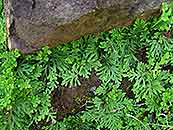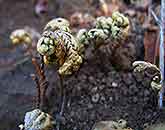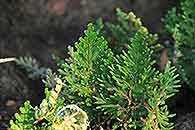Selaginella imbricata (Forssk.) Spring ex Decne.
Synonyms |
Lycopodium imbricatum Forsk. |
|---|---|
Common name |
|
Description |
Plants 5-30 cm high, branched in the upper half and each branch again branching 2 or 3 times, deltoid to ovate-lanceolate in outline, branchlets and leaves curling inwards when dry. Stems erect, tufted or closely spaced, 1 to 3 from a stout, shortly creeping rhizome. Leaves green on upper surface, pale creamy green through beige to almost silvery grey on lower surface, dimorphic, closely overlapping. Upper leaves up to 1.5 × 0.7 mm, ovate to oblong-lanceolate in outline, apex rounded, margin toothed, hyaline. Lateral leaves 1.5-2 × 0.5-1.2 mm, asymmetrically broadly ovate in outline, apex pointed, base adnate to the stem, margin lacerate-serrate and hyaline. Strobili 5-11 mm long, at tips of ultimate branches, male below, female above. Sporophylls uniform, ovate, pointed, margin toothed, smaller and more contracted than the sterile leaves. |
Notes | A very distinctive species, with erect stems and discolorous leaves, that should not be confused with any other Selaginella. |
Derivation | imbricata: overlapping, refers to the strictly overlapping arrangement of the leaves. |
Habitat | On basalt rock, in calcareous rocky places, in dry deciduous open woodland at the base of rocks or in rock crevices. |
Distribution worldwide | Africa, Madagascar. |
Distribution in Africa |
Eritrea, Ethiopia, Kenya, Lesotho, Mozambique, Namibia, Somalia, South Africa, Sudan and South Sudan, Swaziland, Zambia, Zimbabwe. |
Growth form |
Lithophytic. |
Literature |
|




